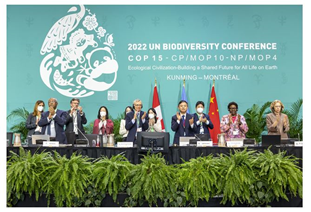Kunming-Montreal Global Biodiversity Framework
- 30 Dec 2022
On 22 December 2022, at the 15th Conference of Parties (COP15) to the UN Convention on Biological Diversity (at Montreal) “Kunming-Montreal Global Biodiversity Framework” (GBF) was adopted.

- The “Kunming-Montreal Global Biodiversity Framework” (GBF), includes four goals and 23 targets to be achieved by 2030.
- The first part of COP 15 took place in Kunming, China and reinforced the commitment to address the biodiversity crisis and the Kunming Declaration was adopted by over 100 countries.
Key Highlights of the Framework
Aim of the Framework
- Address biodiversity loss, restore ecosystems and protect indigenous rights. The plan includes concrete measures to halt and reverse nature loss, including putting 30 per cent of the planet and 30 per cent of degraded ecosystems under protection by 2030.
Targets
- GBF includes 4 goals and 23 targets for achievement by 2030.
- Effective conservation and management of at least 30 per cent of the world’s land, coastal areas and oceans.
| 30x30 Deal
|
- Currently, 17 per cent of land and 10 per cent of marine areas are under protection.
- Reduce to near zero the loss of areas of high biodiversity importance and high ecological integrity
- Halving global food waste
- Phasing out or reforming subsidies that harm biodiversity by at least $500 billion per year, while scaling up positive incentives for biodiversity conservation and sustainable use
- Mobilizing at least $200 billion per year from public and private sources for biodiversity-related funding
- Raising international financial flows from developed to developing countries to at least US$ 30 billion per year
- Requiring transnational companies and financial institutions to monitor, assess, and transparently disclose risks and impacts on biodiversity through their operations, portfolios, supply and value chains
Reporting of the Outcomes
- The countries will monitor and report every five years or less on a large set of indicators related to progress. The CBD will combine national information submitted by late February 2026 and late June 2029 into global trends and progress reports.
Creation of a Dedicated Fund
- The Global Environment Facility has been requested to establish a Special Trust Fund to support the implementation of the Global Biodiversity Framework (“GBF Fund”). This is to ensure successful implementation.
Big Companies Report Impacts on Biodiversity
- Companies should analyse and report how their operations affect and are affected by biodiversity issues.
Pollution and Pesticides
- One of the deal’s more controversial targets sought to reduce the use of pesticides by up to two-thirds.
- Overall, the Kunming-Montreal agreement will focus on reducing the negative impacts of pollution to levels that are not considered harmful to nature, but the text provides no quantifiable target here.
India at the Conference
- India mainly put forward the arguments for supporting the case of developing countries and suggested for the creation of a biodiversity fund to help developing countries successfully implement the global framework.
- India also called for the application of the ‘Common but Differentiated Responsibilities and Respective Capabilities’ (CBDR) principle.
- India was represented at the conference by Union Environment Minister Mr. Bhupendra Yadav.
About Convention on Biodiversity (CBD)
- The CBD known informally as the Biodiversity Convention is a multilateral treaty having its origin at the Rio Earth Summit in 1992.
- It is a legally binding treaty to conserve biodiversity that has been in force since 1993 and has been ratified by 196 nations.
- The convention has three main goals: the conservation of biodiversity, the sustainable use of its components, the fair and equitable sharing of benefits arising from genetic resources.
- Its objective is to develop national strategies for the conservation and sustainable use of biological diversity, and it is often seen as the key document regarding sustainable development.
- The CBD Secretariat is based in Montreal, Canada.
- It has two supplementary agreements, the Cartagena Protocol and Nagoya Protocol.
- In 2000, Cartagena Protocol on Biosafety was adopted. It came into force on 11th September 2003.
- The Nagoya Protocol on Access to Genetic Resources and the Fair and Equitable Sharing of Benefits Arising from their Utilization (ABS) was adopted in 2010.
- It was adopted at COP10 in Nagoya, Japan; and entered into force on 12th October 2014.




